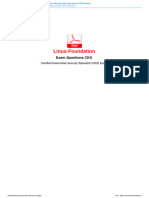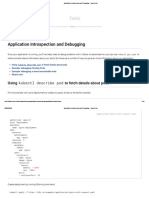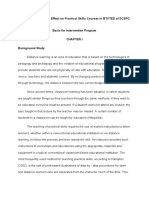0 ratings0% found this document useful (0 votes)
23 viewsKubernetes Common Errors & Troubleshooting
Wu
Uploaded by
yoxami9858Copyright
© © All Rights Reserved
Available Formats
Download as PDF, TXT or read online on Scribd
0 ratings0% found this document useful (0 votes)
23 viewsKubernetes Common Errors & Troubleshooting
Wu
Uploaded by
yoxami9858Copyright
© © All Rights Reserved
Available Formats
Download as PDF, TXT or read online on Scribd
You are on page 1/ 10
DevOps Shack
50 Common Kubernetes Errors With
. Troubleshooting & Examples
1. Pod in CrashLoopBackOff State:
o Error: The pod keeps crashing and restarting.
o Troubleshooting: Check pod logs for errors, ensure required resources are
available, check for misconfigurations.
o Example: kubectl logs <pod-name>
2. ImagePullBackOff:
o Error: Kubernetes is unable to pull the container image.
o Troubleshooting: Verify image name and access permissions, check network
connectivity.
o Example: kubectl describe pod <pod-name>
3. Pod Pending:
o Error: Pod is stuck in the Pending state.
o Troubleshooting: Insufficient resources, node issues, pod scheduling
constraints.
o Example: kubectl describe pod <pod-name>
4. Invalid Pod Specification:
o Error: Pod spec contains invalid configurations.
o Troubleshooting: Review pod YAML file for syntax errors, missing fields, or
incorrect values.
o Example: kubectl apply -f <pod-spec.yaml> --dry-run=client
5. Service Unavailable:
o Error: Service is not reachable.
o Troubleshooting: Check service configuration, endpoint readiness, network
policies.
o Example: kubectl get svc
6. Node Not Ready:
o Error: Node is not ready to accept pods.
o Troubleshooting: Inspect node status, check system logs, monitor resource
usage.
o Example: kubectl describe node <node-name>
7. Volume Mount Errors:
o Error: Issues with mounting volumes in pods.
o Troubleshooting: Verify volume configuration, permissions, and storage
availability.
o Example: kubectl describe pod <pod-name>
8. RBAC Permission Denied:
o Error: User or service account lacks necessary permissions.
o Troubleshooting: Review RBAC roles and bindings, check cluster role
permissions.
o Example: kubectl auth can-i <verb> <resource> --as <user>
9. Pod Evicted:
o Error: Pod is evicted from the node.
o Troubleshooting: Resource constraints, node issues, pod priority
configuration.
o Example: kubectl describe pod <pod-name>
10. Network Policy Issues:
o Error: Network policies are blocking pod communication.
o Troubleshooting: Review network policy configurations, check pod labels and
selectors.
o Example: kubectl describe networkpolicy <policy-name>
11. ImageNotFound:
o Error: Kubernetes cannot find the specified container image.
o Troubleshooting: Verify image name and repository, check image availability.
o Example: kubectl describe pod <pod-name>
12. Init Container Errors:
o Error: Issues with init containers failing to start or complete.
o Troubleshooting: Check init container logs, verify dependencies, and
container startup order.
o Example: kubectl logs <pod-name> -c <init-container-name>
13. Node Out of Disk Space:
o Error: Node has insufficient disk space.
o Troubleshooting: Free up disk space, resize volumes, or add additional
storage.
o Example: df -h
14. Pod Stuck in Terminating State:
o Error: Pod is stuck terminating and not being removed.
o Troubleshooting: Manually delete pod finalizers, check controller-manager
logs.
o Example: kubectl delete pod <pod-name> --grace-period=0 –force
15. Invalid Namespace:
o Error: Specified namespace does not exist or is misspelled.
o Troubleshooting: Check namespace spelling, create namespace if necessary.
o Example: kubectl get namespace
16. Invalid Pod IP:
o Error: Pod IP is not assigned or is invalid.
o Troubleshooting: Check networking configurations, restart kubelet service.
o Example: kubectl describe pod <pod-name>
17. DNS Resolution Failure:
o Error: Pod cannot resolve DNS names.
o Troubleshooting: Verify DNS configurations, check network policies, test DNS
resolution.
o Example: kubectl exec -it <pod-name> -- nslookup <domain>
18. CrashLoopBackOff with Custom Controllers:
o Error: Custom controller-managed pods are in CrashLoopBackOff state.
o Troubleshooting: Check controller logs, review controller implementation,
inspect pod resources.
o Example: kubectl logs <controller-pod-name>
19. ConfigMap Errors:
o Error: Issues with ConfigMap creation or usage in pods.
o Troubleshooting: Verify ConfigMap configurations, check for syntax errors.
o Example: kubectl describe configmap <configmap-name>
20. Pod Security Context Violation:
o Error: Pod security context constraints are violated.
o Troubleshooting: Review pod security context, check security policies.
o Example: kubectl describe pod <pod-name>
21. Node NotReady Condition:
o Error: Node is marked as NotReady.
o Troubleshooting: Check node status, inspect kubelet logs, monitor node
health.
o Example: kubectl describe node <node-name>
22. PersistentVolumeClaim Pending:
o Error: PVC is stuck in Pending state.
o Troubleshooting: Check storage class availability, inspect PV/PVC bindings.
o Example: kubectl describe pvc <pvc-name>
23. Scheduler Errors:
o Error: Issues with pod scheduling.
o Troubleshooting: Inspect scheduler logs, check resource requests/limits.
o Example: kubectl logs -n kube-system <scheduler-pod-name>
24. Missing Resource Quotas:
o Error: Resource quota limits are exceeded.
o Troubleshooting: Review resource quotas, adjust resource requests/limits.
o Example: kubectl describe quota <quota-name>
25. Container Terminated Unexpectedly:
o Error: Container inside the pod is terminated unexpectedly.
o Troubleshooting: Check container logs, inspect container health checks,
review application code.
o Example: kubectl logs <pod-name>
26. Secret Decryption Error:
o Error: Unable to decrypt secrets.
o Troubleshooting: Verify encryption configurations, check secret permissions.
o Example: kubectl describe secret <secret-name>
27. Pod Running Slow:
o Error: Pod is taking longer than expected to start or respond.
o Troubleshooting: Check pod resource utilization, inspect application
performance.
o Example: kubectl top pod <pod-name>
28. Node Crashed:
o Error: Node has crashed and is not recoverable.
o Troubleshooting: Diagnosenode hardware/software issues, replace node if
necessary.
o Example: kubectl describe node <node-name>
29. Deployment Rollout Stuck:
o Error: Deployment rollout is stuck or paused.
o Troubleshooting: Inspect deployment status, check for conflicts or blocking
conditions.
o Example: kubectl rollout status deployment <deployment-name>
30. Ingress Controller Errors:
o Error: Ingress controller is not routing traffic correctly.
o Troubleshooting: Check ingress controller logs, inspect ingress resources,
verify DNS resolution.
o Example: kubectl logs -n <ingress-controller-namespace> <ingress-
controller-pod-name>
31. Pod Affinity/Anti-Affinity Failures:
o Error: Pod scheduling based on affinity/anti-affinity rules fails.
o Troubleshooting: Review pod affinity/anti-affinity configurations, check node
labels.
o Example: kubectl describe pod <pod-name>
32. Horizontal Pod Autoscaler (HPA) Not Scaling:
o Error: HPA is not scaling pods as expected.
o Troubleshooting: Inspect HPA configurations, check resource metrics, review
pod utilization.
o Example: kubectl describe hpa <hpa-name>
33. Service Account Permissions:
o Error: Service account lacks necessary permissions to access resources.
o Troubleshooting: Review service account roles and role bindings.
o Example: kubectl describe sa <service-account-name>
34. Pod Disruption Budget Violation:
o Error: Pod disruption budget constraints are violated.
o Troubleshooting: Review PodDisruptionBudget configurations, check for pod
disruptions.
o Example: kubectl describe pdb <pdb-name>
35. Node Resource Exhaustion:
o Error: Node resources (CPU, memory) are exhausted.
o Troubleshooting: Monitor node resource utilization, adjust resource quotas.
o Example: kubectl top node
36. Custom Resource Definition (CRD) Errors:
o Error: Issues with custom resource definitions.
o Troubleshooting: Check CRD configurations, validate CR manifests.
o Example: kubectl get crd
37. Pod Security Policy Violation:
o Error: Pod does not comply with pod security policies.
o Troubleshooting: Review pod security policy configurations, check for policy
violations.
o Example: kubectl describe pod <pod-name>
38. Cluster Autoscaler Not Scaling:
o Error: Cluster autoscaler is not scaling nodes as expected.
o Troubleshooting: Inspect cluster autoscaler logs, check node utilization,
adjust autoscaler configurations.
o Example: kubectl logs -n kube-system <autoscaler-pod-name>
39. Pod Resource Contention:
o Error: Pods on the node are contending for resources.
o Troubleshooting: Review resource requests/limits, adjust pod scheduling
policies.
o Example: kubectl describe pod <pod-name>
40. Endpoint Not Ready:
o Error: Service endpoint is not ready to receive traffic.
o Troubleshooting: Check service health checks, review endpoint status.
o Example: kubectl describe endpoints <service-name>
41. Namespace Resource Quota Exceeded:
o Error: Resource quota limits in namespace exceeded.
o Troubleshooting: Adjust resource quotas, monitor namespace resource
usage.
o Example: kubectl describe quota -n <namespace-name>
42. Node Drain Failure:
o Error: Node drain operation fails.
o Troubleshooting: Manually evacuate pods from the node, check for stuck
processes.
o Example: kubectl drain <node-name>
43. Invalid Service Type:
o Error: Service type is invalid or unsupported.
o Troubleshooting: Review service type in service manifest.
o Example: kubectl describe service <service-name>
44. Cluster DNS Resolution Failure:
o Error: Cluster DNS service is not resolving names correctly.
o Troubleshooting: Verify CoreDNS configurations, check for DNS service
availability.
o Example: kubectl get svc -n kube-system
45. Pod Affected by Node Maintenance:
o Error: Pod is affected by node maintenance activities.
o Troubleshooting: Evacuate pods from the node, ensure node cordoning.
o Example: kubectl drain <node-name>
46. Ingress Resource Misconfiguration:
o Error: Ingress resource is misconfigured.
o Troubleshooting: Review ingress YAML file, check backend service
configurations.
o Example: kubectl describe ingress <ingress-name>
47. API Server Unavailable:
o Error: Kubernetes API server is unreachable.
o Troubleshooting: Check API server logs, review network connectivity.
o Example: kubectl cluster-info
48. Node Affinity Violation:
o Error: Pod scheduling based on node affinity rules fails.
o Troubleshooting: Review pod/node labels, inspect node affinity
configurations.
o Example: kubectl describe pod <pod-name>
49. Pod Priority Preemption:
o Error: Pods with lower priority are preempted by higher-priority pods.
o Troubleshooting: Adjust pod priority settings, review preemption policies.
o Example: kubectl describe pod <pod-name>
50. Volume Quota Exceeded:
o Error: Persistent volume quota limits exceeded.
o Troubleshooting: Adjust storage quotas, monitor persistent volume usage.
o Example: kubectl describe quota <quota-name>
You might also like
- Laboratory Studies in Integrated Principles of Zoology 18th EditionNo ratings yetLaboratory Studies in Integrated Principles of Zoology 18th Edition54 pages
- 100 K8 Errors Solution by DevOps Shack 1712799024No ratings yet100 K8 Errors Solution by DevOps Shack 171279902425 pages
- DevOps Shack _ 100 Common Kubernetes Errors and SolutionsNo ratings yetDevOps Shack _ 100 Common Kubernetes Errors and Solutions54 pages
- Kubernetes real time errors and TroubleshootingNo ratings yetKubernetes real time errors and Troubleshooting3 pages
- 100 Kubernetes Errors With Solution in DetailNo ratings yet100 Kubernetes Errors With Solution in Detail30 pages
- List of K8s Errors & Troubleshooting tipsNo ratings yetList of K8s Errors & Troubleshooting tips3 pages
- Kubernetes Troubleshooting The Complete GuideNo ratings yetKubernetes Troubleshooting The Complete Guide30 pages
- Pods Not Starting Issue: Pod Troubleshooting KubernetesNo ratings yetPods Not Starting Issue: Pod Troubleshooting Kubernetes4 pages
- Kubernetes Troubleshooting Steps with Answers Pocket GuideNo ratings yetKubernetes Troubleshooting Steps with Answers Pocket Guide149 pages
- 55+ K8s Issues and Remediations You Should Be Aware ofNo ratings yet55+ K8s Issues and Remediations You Should Be Aware of21 pages
- Troubleshooting Kubernetes Scenarios Part 2No ratings yetTroubleshooting Kubernetes Scenarios Part 25 pages
- Part_6_Kubernetes_Real_Time_Troubleshooting_1721726699No ratings yetPart_6_Kubernetes_Real_Time_Troubleshooting_17217266995 pages
- Part 10 Kubernetes Real Time Troubleshooting 1721726638No ratings yetPart 10 Kubernetes Real Time Troubleshooting 17217266386 pages
- Diagnosing and Resolving Performance Errors in KubernetesNo ratings yetDiagnosing and Resolving Performance Errors in Kubernetes21 pages
- Part 3 - Kubernetes Real-Time TroubleshootingNo ratings yetPart 3 - Kubernetes Real-Time Troubleshooting5 pages
- 100 Kubernetes Tips & Useful Tricks With Usecases Part 1,2,3,4,5No ratings yet100 Kubernetes Tips & Useful Tricks With Usecases Part 1,2,3,4,521 pages
- Lesson 9 Troubleshooting Application Failures Control Panel Failures Network FailuresNo ratings yetLesson 9 Troubleshooting Application Failures Control Panel Failures Network Failures38 pages
- Part_7_Kubernetes_Real_Time_Troubleshooting_1721726688No ratings yetPart_7_Kubernetes_Real_Time_Troubleshooting_17217266886 pages
- Part 9 Kubernetes Real Time Troubleshooting 1721726663No ratings yetPart 9 Kubernetes Real Time Troubleshooting 17217266636 pages
- Linux Foundation Passleader Cks Study Guide 2022-May-02 by Sebastian 22q VceNo ratings yetLinux Foundation Passleader Cks Study Guide 2022-May-02 by Sebastian 22q Vce9 pages
- CKA - Kubernetes Certified Administrator CheatsheetNo ratings yetCKA - Kubernetes Certified Administrator Cheatsheet9 pages
- Troubleshooting Kubernetes Scenarios Part 11 PDF 1721659767No ratings yetTroubleshooting Kubernetes Scenarios Part 11 PDF 17216597677 pages
- (English) Day-1 - Kubernetes Troubleshooting - ImagePullBackOff - How To Use Private Images in Kubernetes (DownSub - Com)No ratings yet(English) Day-1 - Kubernetes Troubleshooting - ImagePullBackOff - How To Use Private Images in Kubernetes (DownSub - Com)26 pages
- Cka Kubernetes Application Developer Crash CourseNo ratings yetCka Kubernetes Application Developer Crash Course172 pages
- Create Cluster Objects by Using Imperative CommandsNo ratings yetCreate Cluster Objects by Using Imperative Commands7 pages
- Docker Error & Solution by DevOps ShackNo ratings yetDocker Error & Solution by DevOps Shack40 pages
- CKA-Application Introspection and DebuggingNo ratings yetCKA-Application Introspection and Debugging16 pages
- Kubernetes Unleashed: Herding Containers Like a DevOps CowboyFrom EverandKubernetes Unleashed: Herding Containers Like a DevOps CowboyNo ratings yet
- Polisomnografí A Dinamica No Dise.: Club de Revistas Julián David Cáceres O. OtorrinolaringologíaNo ratings yetPolisomnografí A Dinamica No Dise.: Club de Revistas Julián David Cáceres O. Otorrinolaringología25 pages
- Review Notes in Working Papers Review Notes in Working PapersNo ratings yetReview Notes in Working Papers Review Notes in Working Papers16 pages
- CV For Road Safety Specialist - PDF - CompressedNo ratings yetCV For Road Safety Specialist - PDF - Compressed8 pages
- Chapter 4 Mechanical Properties of MetalsNo ratings yetChapter 4 Mechanical Properties of Metals19 pages
- Distance Learning and Effect On Practical Skills Courses in BTVTED of ZCSPCNo ratings yetDistance Learning and Effect On Practical Skills Courses in BTVTED of ZCSPC12 pages
- MEDIATION TEAM’S SEVENTEENTH NOTICE AND REPORTNo ratings yetMEDIATION TEAM’S SEVENTEENTH NOTICE AND REPORT7 pages
- New Twists in The Unfolded Protein Response: Cell BiologyNo ratings yetNew Twists in The Unfolded Protein Response: Cell Biology4 pages
- Reflective Practice Using Assessment DataNo ratings yetReflective Practice Using Assessment Data58 pages
- (Ebook) Pulp & Paper Chemistry & Technology V1 - Paper Products Physics and Technology by Monica Ek, Göran Gellerstedt, Gunnar Henriksson (Editors) ISBN 9783110213454, 3110213451 - Download the ebook now to never miss important informationNo ratings yet(Ebook) Pulp & Paper Chemistry & Technology V1 - Paper Products Physics and Technology by Monica Ek, Göran Gellerstedt, Gunnar Henriksson (Editors) ISBN 9783110213454, 3110213451 - Download the ebook now to never miss important information51 pages
- IMPORTANT TOPICS - SCIENCE Class 10th (PRASHANT KIRAD) - Class - 10th - Most - Important - Topics (Prashant - Kirad)No ratings yetIMPORTANT TOPICS - SCIENCE Class 10th (PRASHANT KIRAD) - Class - 10th - Most - Important - Topics (Prashant - Kirad)5 pages
- Promotional Strategies & Print Ad For Cold Creams100% (1)Promotional Strategies & Print Ad For Cold Creams12 pages
- 10th Samacheer Kalvi Maths EM Public Exam QP Sample 4 PDFNo ratings yet10th Samacheer Kalvi Maths EM Public Exam QP Sample 4 PDF4 pages
- AE Operation and Maintenance Manual of 170 Series Marine Diesel EngineNo ratings yetAE Operation and Maintenance Manual of 170 Series Marine Diesel Engine123 pages
- Sample Clil Lesson Plan - Primary School ArtNo ratings yetSample Clil Lesson Plan - Primary School Art4 pages
- Laboratory Studies in Integrated Principles of Zoology 18th EditionLaboratory Studies in Integrated Principles of Zoology 18th Edition
- DevOps Shack _ 100 Common Kubernetes Errors and SolutionsDevOps Shack _ 100 Common Kubernetes Errors and Solutions
- Pods Not Starting Issue: Pod Troubleshooting KubernetesPods Not Starting Issue: Pod Troubleshooting Kubernetes
- Kubernetes Troubleshooting Steps with Answers Pocket GuideKubernetes Troubleshooting Steps with Answers Pocket Guide
- 55+ K8s Issues and Remediations You Should Be Aware of55+ K8s Issues and Remediations You Should Be Aware of
- Part_6_Kubernetes_Real_Time_Troubleshooting_1721726699Part_6_Kubernetes_Real_Time_Troubleshooting_1721726699
- Part 10 Kubernetes Real Time Troubleshooting 1721726638Part 10 Kubernetes Real Time Troubleshooting 1721726638
- Diagnosing and Resolving Performance Errors in KubernetesDiagnosing and Resolving Performance Errors in Kubernetes
- 100 Kubernetes Tips & Useful Tricks With Usecases Part 1,2,3,4,5100 Kubernetes Tips & Useful Tricks With Usecases Part 1,2,3,4,5
- Lesson 9 Troubleshooting Application Failures Control Panel Failures Network FailuresLesson 9 Troubleshooting Application Failures Control Panel Failures Network Failures
- Part_7_Kubernetes_Real_Time_Troubleshooting_1721726688Part_7_Kubernetes_Real_Time_Troubleshooting_1721726688
- Part 9 Kubernetes Real Time Troubleshooting 1721726663Part 9 Kubernetes Real Time Troubleshooting 1721726663
- Linux Foundation Passleader Cks Study Guide 2022-May-02 by Sebastian 22q VceLinux Foundation Passleader Cks Study Guide 2022-May-02 by Sebastian 22q Vce
- CKA - Kubernetes Certified Administrator CheatsheetCKA - Kubernetes Certified Administrator Cheatsheet
- Troubleshooting Kubernetes Scenarios Part 11 PDF 1721659767Troubleshooting Kubernetes Scenarios Part 11 PDF 1721659767
- (English) Day-1 - Kubernetes Troubleshooting - ImagePullBackOff - How To Use Private Images in Kubernetes (DownSub - Com)(English) Day-1 - Kubernetes Troubleshooting - ImagePullBackOff - How To Use Private Images in Kubernetes (DownSub - Com)
- Create Cluster Objects by Using Imperative CommandsCreate Cluster Objects by Using Imperative Commands
- Kubernetes Unleashed: Herding Containers Like a DevOps CowboyFrom EverandKubernetes Unleashed: Herding Containers Like a DevOps Cowboy
- Polisomnografí A Dinamica No Dise.: Club de Revistas Julián David Cáceres O. OtorrinolaringologíaPolisomnografí A Dinamica No Dise.: Club de Revistas Julián David Cáceres O. Otorrinolaringología
- Review Notes in Working Papers Review Notes in Working PapersReview Notes in Working Papers Review Notes in Working Papers
- Distance Learning and Effect On Practical Skills Courses in BTVTED of ZCSPCDistance Learning and Effect On Practical Skills Courses in BTVTED of ZCSPC
- New Twists in The Unfolded Protein Response: Cell BiologyNew Twists in The Unfolded Protein Response: Cell Biology
- (Ebook) Pulp & Paper Chemistry & Technology V1 - Paper Products Physics and Technology by Monica Ek, Göran Gellerstedt, Gunnar Henriksson (Editors) ISBN 9783110213454, 3110213451 - Download the ebook now to never miss important information(Ebook) Pulp & Paper Chemistry & Technology V1 - Paper Products Physics and Technology by Monica Ek, Göran Gellerstedt, Gunnar Henriksson (Editors) ISBN 9783110213454, 3110213451 - Download the ebook now to never miss important information
- IMPORTANT TOPICS - SCIENCE Class 10th (PRASHANT KIRAD) - Class - 10th - Most - Important - Topics (Prashant - Kirad)IMPORTANT TOPICS - SCIENCE Class 10th (PRASHANT KIRAD) - Class - 10th - Most - Important - Topics (Prashant - Kirad)
- 10th Samacheer Kalvi Maths EM Public Exam QP Sample 4 PDF10th Samacheer Kalvi Maths EM Public Exam QP Sample 4 PDF
- AE Operation and Maintenance Manual of 170 Series Marine Diesel EngineAE Operation and Maintenance Manual of 170 Series Marine Diesel Engine

























































































